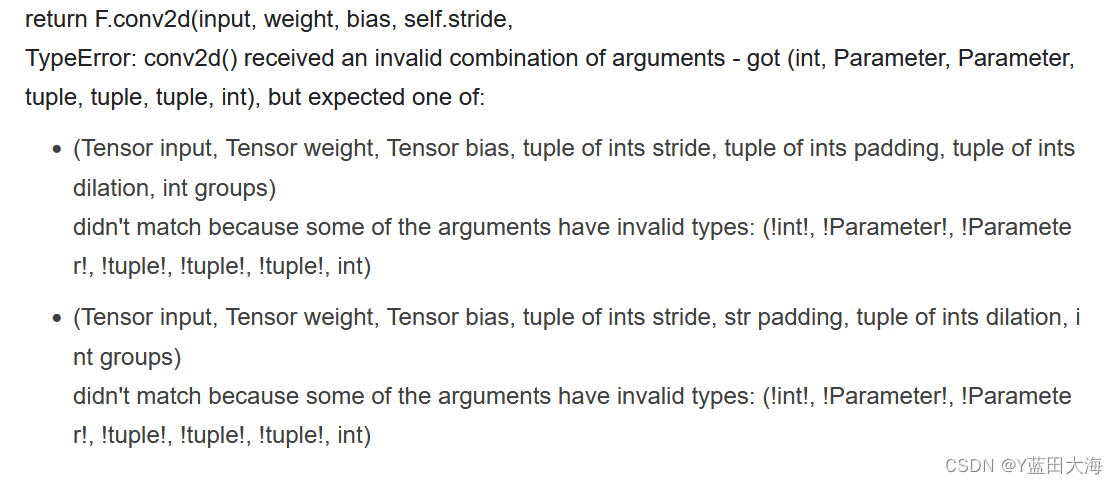1.
看b站视频用卷积进行手写数字识别源代码如下:
#输入为28*28*1 经过第一次卷积计算后为 28*28*16 池化变为14*14*16 第二次卷积14*14*32 池化7*7*32即全连接(10为10分类)
#前向传播:经过卷积1、2 再把结果转化为向量格式 结果×全连接层(w*x+b)
import torch
import torch.nn as nn
import torch.optim as optim
from torchvision import datasets,transforms
#定义超参数
input_size = 28 #图像的总尺寸28*28
num_classes = 10 #标签的种类数
num_epochs = 3 #训练的总循环周期
batch_size = 64 #一个撮(批次)的大小,64张图片
# 数据集
train_dataset = datasets.MNIST("./data",train=True,transform=transforms.ToTensor(),download=True)
test_dataset = datasets.MNIST("./data",train=False,transform=transforms.ToTensor())
#构建batch数据
train_loader = torch.utils.data.DataLoader(dataset=train_dataset,batch_size=batch_size,shuffle=True)
test_loader = torch.utils.data.DataLoader(dataset=test_dataset,batch_size=batch_size,shuffle=True)
class CNN(nn.Module):
def __init__(self):
super(CNN,self).__init__()
self.conv1=nn.Sequential( #输入大小(1, 28,28)
nn.Conv2d(
in_channels=1, #灰度图
out_channels=16, #要得到几多少个特征图
kernel_size=5, #卷积核大小
stride=1, #步长
padding=2, #如果希望卷积后大小跟原来一样, 需要设置padding=(kerneI_size-1)/2 if stride=1
), #输出的特征图为(16, 28, 28)
nn.ReLU(), # relu层
nn.MaxPool2d(kernel_size=2), #进行池化操作(2x2区域),输出结果为: (16, 14, 14)
)
self.conv2 = nn.Sequential( #下一个套餐的输入(16, 14, 14)
nn.Conv2d(16,32,5,1,2), #输出(32, 14,14)此处的16为上面的到的16个特征图
nn.ReLU(), # relu层
nn.MaxPool2d(2), #输出(32,7,7)
)
self.out = nn.Linear(32*7*7,10) # 全连接层得到的结果(输入32*37*7 输出10)
def forward(self,x): #前向传播
x = self.conv1(x),
x = self.conv2(x)
x = x.view(x.size(0),-1) #flatten操作,结果为: (batch_ size, 32*7*7)
output = self.out(x) #上步向量乘全连接层
return output
def accuracy(predictions, labels):
pred = torch.max(predictions.data,1)[1]
rights = pred.eq(labels.data.view_as(pred)).sum()
return rights, len(labels)
#实例化
net = CNN()
#损失函数
criterion = nn.CrossEntropyLoss()
#优化器
optimizer = optim.Adam(net.parameters(), lr=0.001) #定义优化器,普通的随机梯度下降算法
#开始训练循环
for epoch in range(num_epochs):
#当前epoch的结果保存下来
train_rights = []
for batch_idx,(data,target) in enumerate(train_loader): #针对容器中的每一个批进行循环
#对于一个可迭代的(iterable)/可遍历的对象(如列表、字符串),enumerate将其组成一个索引序列,利用它可以同时获得索引和值
net.train()
output=net(data)
loss = criterion(output,target)
optimizer.zero_grad()
loss.backward()
optimizer.step()
right = accuracy(output,target)
train_rights.append(right)
if batch_idx % 100 == 0:
net.eval()
val_rights = [] #保存精度
for (data,target) in test_loader:
output = net(data)
right = accuracy(output,target)
val_rights.append(right)
#准确率计算
train_r = (sum([tup[0] for tup in train_rights]),sum([tup[1] for tup in train_rights]))
val_r = (sum([tup[0] for tup in val_rights]),sum([tup[1] for tup in val_rights]))
print('当前epoch:{} [{}/{} ({:.0f}%)]\t 损失: {:.6f}\t 训练集准确率: {:.2f}%\t 测试集正确率: {:.2f}%'.format(
epoch, batch_idx * batch_size, len(train_loader.dataset),
100.*batch_idx / len(train_loader),
loss.data,
100. * train_r[0].numpy() / train_r[1],
100. * val_r[0].numpy() / val_r[1]))运行代码报如下错误:

看了一下大概意思就是往conv2传的参数格式不对,检查一下,发现太粗心,在54行多打了个“,”修改后正常运行了

2.
改完后搜了一下,看看有没有同学跟我一样粗心的,发现一个同学也报同样的错误,但不是多了一个逗号,他的源代码如下:
import torch
import torch.nn as nn
from torchvision import datasets, transforms
from torchvision.datasets import MNIST
import torch.optim as optim
import numpy as np
import torch.nn.functional as F
import matplotlib.pyplot as plt
from torch.utils.data import DataLoader
# -- 定义超参数
input_size = 28 # -- 图片尺寸28*28
num_class = 10 # -- 最后分类情况 10分类0-9
num_epochs = 3 # -- 循环3个周期
batch_size = 64 # -- batch大小64
# -- 训练集
train_dataset = MNIST(root="./data/", train=True, transform=transforms.ToTensor(), download=True)
# -- 测试集
test_dataset = MNIST(root="./data/", train=False, transform=transforms.ToTensor())
# -- 构建batch数据
train_loader = DataLoader(dataset=train_dataset,
batch_size=batch_size,
shuffle=True)
test_loader = DataLoader(dataset=test_dataset,
batch_size=batch_size,
shuffle=True)
# -- 定义模型
class CNN_Model(nn.Module):
def __init__(self):
super(CNN_Model, self).__init__()
# -- 第一个卷积单元 卷积 relu 池化 输入图为28*28*1 输出结果为 16 *14 *14
self.conv1 = nn.Sequential(
nn.Conv2d(in_channels=1, # -- 输入的灰度图 1通道 所以是1
out_channels=16, # -- 想得到多少个特征图 输出的特征图16个
kernel_size=5, # -- 卷积核的大小 5*5 提取成1个点
stride=1, # -- 步长为1
padding=2 # -- 填充0
),
nn.ReLU(), # -- relu层
nn.MaxPool2d(kernel_size=2) # -- 池化操作 输出结果为 16 *14 *14
)
# -- 第二个卷积单元 输入为16*14*14 输出10分类
self.conv2 = nn.Sequential(
nn.Conv2d(16, 32, 5, 1, 2), # -- 输入为16*14*14
nn.ReLU(),
nn.MaxPool2d(2) # -- 输出为32*7*7
)
self.out = nn.Linear(32 * 7 * 7, 10) # -- 全连接层 输出10分类
# -- 前向传播
def forward(self, x):
x = self.conv1(x)
x = self.conv2(x)
x = x.view(x.size(0), -1) # -- flatten操作 拉成一维数组形式 才能进行全连接输出
output = self.out(x)
return output
# -- 定义一个评估函数
def pinggu(predictions, labels):
pred = torch.max(predictions.data, 1)[1]
right = pred.eq(labels.data.view_as(pred)).sum()
return right, len(labels)
# -- 训练网络模型
# -- 实例化
mymodel = CNN_Model()
# -- 损失函数
loss_fn = nn.CrossEntropyLoss()
# -- 优化器 # 普通的随机梯度下降
optimizer = optim.Adam(mymodel.parameters(), lr=0.001)
# -- 开始训练
for epoch in range(num_epochs):
# -- 当前epoch结果保存起来
train_right = []
for batch_idx, (data, target) in enumerate(train_loader):
mymodel.train()
output = mymodel(data)
loss = loss_fn(output, target)
optimizer.zero_grad()
loss.backward()
optimizer.step()
right = pinggu(output, target)
train_right.append(right)
if batch_idx % 100 == 0:
mymodel.eval()
val_right = []
for (data, target) in enumerate(test_loader):
output = mymodel(data)
right = pinggu(output, target)
val_right.append(right)
# -- 准确率计算
train_r = (sum([tup[0] for tup in train_right]), sum([tup[1] for tup in train_right]))
val_r = (sum([tup[0] for tup in val_right]), sum([tup[1] for tup in val_right]))
print('当前epoch:{} [{}/{} ({:.0f}%)]\t 损失:{:.6f}\t 训练集准确率: {:.2f}%\t 测试集准确率:{:.2f}%'.format(
epoch, batch_idx * batch_size, len(train_loader.dataset),
100. * batch_idx / len(train_loader),
loss.data,
100. * train_r[0].numpy() / train_r[1],
100. * val_r[0].numpy() / val_r[1]
))他报的错误如下:

看了一下也是传入的参数格式不对,只需要把95行修改一下
for (data, target) in enumerate(test_loader):
改为
for (data, target) in test_loader:修改前:
for (data, target) in enumerate(test_loader):
#输出data结果为
0
1
2
.
.
data格式为int
修改后:
for (data, target) in test_loader:
输出结果为:
tensor([[[[0., 0., 0., ..., 0., 0., 0.],
[0., 0., 0., ..., 0., 0., 0.],
[0., 0., 0., ..., 0., 0., 0.],
格式为Tensor再看一下报错:

原因:人家要的是Tensor,你传的是int
3.总结
该问题就是传入的参数格式不对,出现问题可以检查一下问题处的数据传入






















 2379
2379











 被折叠的 条评论
为什么被折叠?
被折叠的 条评论
为什么被折叠?








